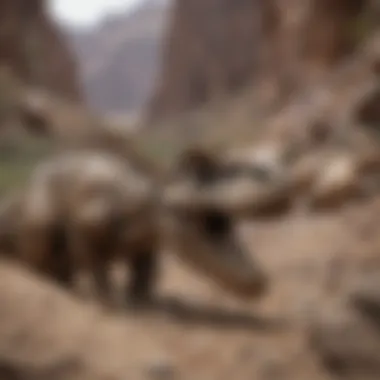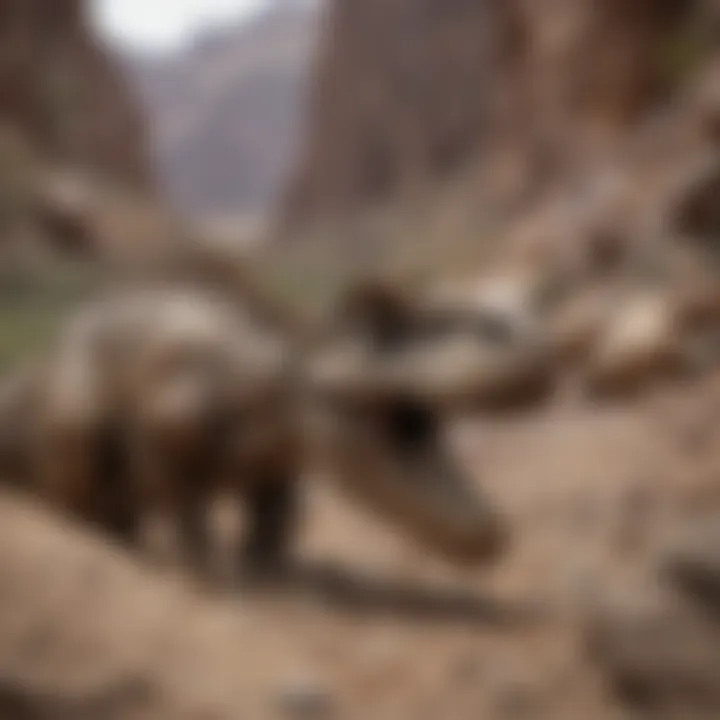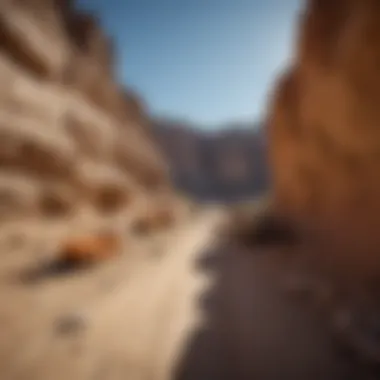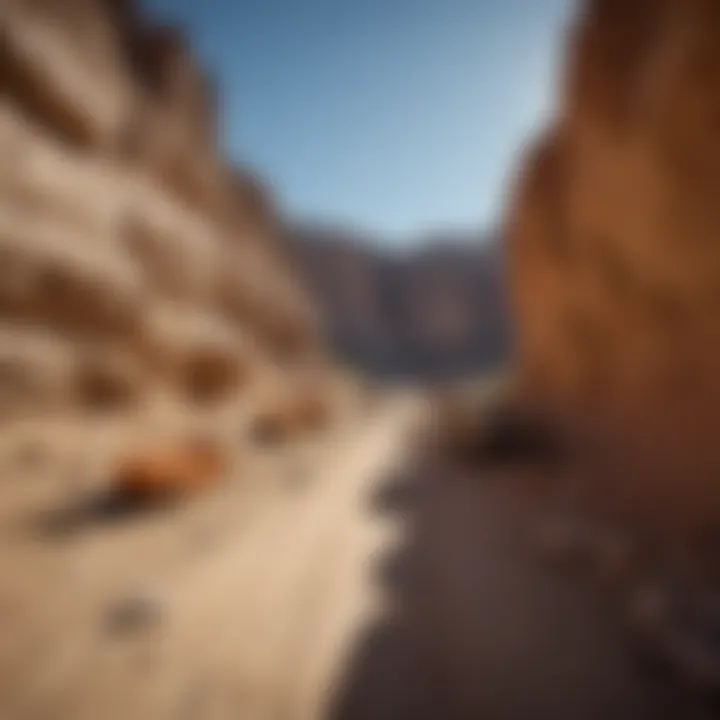Uncovering Utah's Rich Paleontological Legacy


Intro
Utah is a treasure trove of paleontological wonders. The state’s diverse geological formations have preserved a myriad of fossils, offering a compelling window into the prehistoric life that once thrived here. This article offers an in-depth look at Utah’s fossil record, focusing on key sites, notable specimens, and the methodologies used in their excavation and preservation. By integrating insights from both amateur collectors and seasoned researchers, we aim to illuminate the significance of these findings and their broader implications for our understanding of natural history.
The importance of studying fossils extends beyond mere collection. They enable scientists to reconstruct ancient environments and climatic conditions, leading to a more holistic understanding of Earth's history. In Utah, various rock layers from different geological periods provide a unique cross-section of life over millions of years. The following sections will explore the featured collectible of the month, identification techniques, and much more, enhancing your appreciation of this fascinating field.
Featured Collectible of the Month
Overview
In the realm of fossil collecting, certain specimens stand out not only for their uniqueness but also for their contribution to understanding prehistoric ecosystems. This month, the spotlight falls on the well-preserved dinosaur bones found in the Morrison Formation. This geological formation is known for housing some of the most significant dinosaur fossils, including those of the Apatosaurus and Stegosaurus.
These fossils not only attract collectors but also researchers keen on studying the behavior and environment of these magnificent creatures. The bones are generally characterized by their large size and distinct features, which help in identifying the species and understanding their locomotion and habitat preferences.
Historical Significance
The Morrison Formation, laid down during the Late Jurassic period, is crammed with fossils that tell the story of a vibrant ecosystem. The discovery of the dinosaur bones in this area has reshaped our understanding of the diversity and distribution of dinosaurs. Notably, discoveries from this formation have contributed to debates regarding the behavior of sauropods versus that of their smaller theropod counterparts.
Researchers and collectors alike value these bones not just for their physical presence, but for what they reveal about the ecosystem in which these dinosaurs lived. Each fossil helps stitch together the intricate tapestry of life millions of years ago, providing critical insights into evolutionary history.
"Fossils are the fingerprints of Earth's history, revealing the story of life and its evolution over millions of years."
Identification Techniques
Visual Characteristics
Identifying fossils requires a keen eye for detail. Common characteristics to focus on include:
- Texture and Surface Patterns: Many fossils exhibit unique textures that indicate their type.
- Size and Shape: The dimensions and forms of the bones can be telling indicators of their origin.
- Fossil Matrix: The surrounding rock matrix can assist in determining the geological period and environment where they were formed.
These visual clues can guide collectors in distinguishing between various types of fossils as well as indicating their potential significance.
Resources for Identification
For those looking to enhance their fossil identification skills, several resources are invaluable:
- Books on Paleontology: Look for guides focusing on local fossils found in Utah, which can provide context and illustrations.
- Online Forums: Websites like Reddit and Facebook groups dedicated to paleontology often discuss identification tips and share resources.
- Museums and Educational Programs: Local museums provide educational programs that can enhance one's understanding of fossil identification and significance.
These resources not only boost identification skills but also foster a deeper appreciation for the science of paleontology.
The Geological Landscape of Utah
The geological landscape of Utah is intricate and compelling. It provides a backdrop for understanding the state's unique fossil record. The layers of rock that make up Utah's terrain tell a story that spans millions of years. This section will explore how these geological factors serve as a foundation for paleontological research and discovery.
Understanding Utah's Geological Strata
Utah's geological strata are diverse, showcasing various formations formed over different geological periods. This stratification is essential for paleontologists. Each layer holds key evidence about the life forms that existed at that time. Analysing these strata allows researchers to reconstruct past climates and ecosystems. It also aids in understanding evolutionary processes.
The significance of geological analysis cannot be overstated. Through careful examination, scientists can determine the age of fossils and their environment. This process requires advanced techniques such as radiometric dating and stratigraphic correlation. These methods provide a much clearer picture of Utah's prehistoric life.
Major Geological Formations
Major geological formations in Utah significantly impact its paleontological wealth. Each formation has characteristics that provide context for fossil discoveries. Understanding these formations is crucial for anyone interested in fossils. Below are some of the key formations worth noting.
Uinta Mountains
The Uinta Mountains are known for their rugged terrain and unique geology. This range is formed mainly of sedimentary rocks. However, its most significant contribution to paleontology is the discovery of fossils embedded in these layers. The Uinta formation yields great dinosaur fossils from the late Jurassic period.
A key characteristic of the Uinta Mountains is that they are one of the few major ranges in the United States that run east to west. This unusual orientation affects local climate and ecosystems, making it a unique environment for fossil preservation. Its high elevation also helps in exposing ancient formations not found in other regions.
The unique feature of the Uinta Mountains is how well-preserved the fossils are, particularly in the red sandstone formations. These provide critical context for understanding dinosaur diversity and behavior in this region. While it poses accessibility challenges due to its ruggedness, the scientific value of these fossils greatly outweighs the disadvantages.
Wasatch Range
The Wasatch Range is another vital geological feature in Utah. This range serves as a major barrier between the Great Basin and the Rocky Mountains. It comprises a mix of sedimentary, igneous, and metamorphic rocks. The diverse geology of the Wasatch Range contributes to a variety of paleontological finds spanning millions of years.
One of the most remarkable aspects of the Wasatch Range is its rich fossil record. Fossils can be found in many different rock layers, offering insights into multiple eras of earth’s history. The range provides a habitat for various prehistoric creatures, including mammals and reptiles. These fossils reflect the changing climates and environments over time.
Additionally, the accessibility of the Wasatch Range makes it a popular choice for fossil hunters and researchers. This ease of access allows for extensive studies and educational activities, promoting further interest in the paleontological significance of Utah.
Colorado Plateau
The Colorado Plateau is a geological wonder that stretches across multiple states, including Utah. It is characterized by a series of high-relief plateaus and provides exciting geological conditions for fossilization. The plateau's sedimentary formations are rich in fossils from different periods, particularly the Mesozoic Era.


A key characteristic of the Colorado Plateau is its spectacular scenery, featuring colorful rock layers that are visually striking. This geological diversity is also beneficial for paleontologists, as it offers numerous opportunities for fossil excavation. The formations here yield a wide array of fossils, from dinosaurs to ancient plants.
The unique feature of the Colorado Plateau is the prevalence of badlands and slickrock, which often reveals fossil beds. However, while the area is rich in fossils, the conditions can also be harsh, making it difficult for extended research activities. Nonetheless, the paleontological benefits provided by the Colorado Plateau make it an essential focus area in understanding Utah's prehistoric life.
Paleontological Significance
The study of fossils in Utah signifies a vital link between prehistoric life and contemporary understanding of biodiversity. Utah's fossil record provides a unique perspective on both the environmental changes over millions of years and the evolutionary pathways that shaped life as we know it today. This significance is not merely academic; it impacts areas from educational frameworks to conservation efforts.
Fossils serve as natural chronometers, offering insights into past climates, ecosystems, and biological transformations. This geological and paleontological wealth enhances our grasp of climatic shifts and extinction events, while also informing current conservation strategies by highlighting these changes over time. Moreover, this understanding has real-world applications, including paleobiogeography and evolutionary biology studies.
Historical Context of Fossil Discovery
Utah's history of fossil discovery is rich and varied, dating back to the 1800s when paleontologists first recognized the region's potential. One of the early significant discoveries occurred in the late 19th century, with the finding of dinosaur bones in areas like the Wasatch Plateau. These initial findings set the stage for subsequent explorations that yielded remarkable fossil specimens, including those housed in the collections of the Natural History Museum of Utah.
Notable figures such as Earl Douglass, who worked for the Carnegie Museum, uncovered substantial discoveries, including the famous "Dinosaur Wall" in Dinosaur National Monument. These early paleontological endeavors laid the foundation for modern paleontology in Utah. Over the years, numerous fossil sites have been documented, leading to a deeper understanding of the region's prehistoric inhabitants.
Evolutionary Insights from Fossils
Fossils are crucial in unraveling the evolutionary narrative of life on Earth. In Utah, specimens such as the Allosaurus and Utahraptor not only offer tangible evidence of their existence but also assist scientists in deciphering the evolutionary trends within the dinosaur lineage. Information obtained from these fossils contributes to understanding how species adapted to their environment, diversified, and sometimes disappeared under pressure from climatic or ecological changes.
Fossils document transitions from reptilian to avian forms in some lineages, illuminating fundamental questions about how life evolves. Additionally, the study of prehistoric marine life, with fossils such as ammonites, reveals a rich tapestry of aquatic evolution. By analyzing these specimens, paleontologists can track changes in biodiversity and speculate on future evolutionary scenarios.
"Paleontology is not merely about dinosaurs. It reaches into the very heart of life's story on Earth, capturing our planet's dynamic biological history."
This significant intersection of paleontology and evolution also provides educational foundations, inspiring the next generation of scientists and enthusiasts. By presenting fossils as part of a broader scientific narrative, Utah cultivates a culture of inquiry and appreciation for the complexities of life.
Through these layers of understanding, the paleontological significance of Utah extends beyond its boundaries, reinforcing the importance of preserving natural history. It ensures continuity in piecing together the grand puzzle of life and its origins.
Notable Fossil Sites in Utah
The study of notable fossil sites in Utah serves as a critical linchpin in understanding the region's rich paleontological history. By exploring these sites, researchers and enthusiasts gain invaluable insights into the various prehistoric life forms that once roamed this land. Each location offers a unique perspective on the evolutionary landscape, allowing for a richer comprehension of various ecosystems that existed millions of years ago. The preservation and display of fossils in these areas also play a significant role in public education and engagement.
The Jurassic National Monument
The Jurassic National Monument is a key site highlighting the significance of Utah's Jurassic period. Here, fossils from the late Jurassic—around 150 million years ago—are well-preserved and provide an intimate glimpse into an ancient world where dinosaurs thrived. The important characteristic of this site is its wealth of dinosaur remains, which include a variety of species that have contributed to our understanding of dinosaur behavior and ecology.
Moreover, the monument serves as a conserved space where scientific research can be undertaken without destructive interference. This protects the integrity of the fossils, allowing for ongoing study, which can yield new insights into the era's biodiversity.
Dinosaur National Monument
Key Discoveries
Key discoveries made at Dinosaur National Monument are of profound importance in the context of paleontology. Among the best-known features here is the fossil quarry, where hundreds of dinosaur bones can be seen in situ. This distinctive characteristic provides a more holistic picture of the ecosystems that existed and the interactions among different species.
The immense size and variety of fossils uncovered at this site make it a popular choice for both academic research and educational visits. This site is especially beneficial for those interested in understanding the context of dinosaur behavior. The presentation of fossils in their original sedimentary layers offers learners a chance to see how these creatures lived and died, making the discoveries strikingly tangible.
Visitor Information
Visitor information for Dinosaur National Monument is essential for facilitating access to this incredible site. The monument provides educational resources and guided tours which enhance the experience of those wanting to learn more about the fossils found there. A key characteristic of this information is its accessibility: brochures, signage, and ranger-led programs serve to inform and engage the public effectively.
The unique feature of several designated trails also allows visitors to explore various facets of the monument beyond just fossils. This breadth of information serves to highlight the geological and ecological significance of the area, enhancing overall visitor engagement and appreciation.
The St. George Dinosaur Discovery Site
The St. George Dinosaur Discovery Site offers another significant glimpse into Utah's prehistoric life. This site is especially appreciated for its collection of tracks left by dinosaurs, which adds a dynamic layer to the study of their behavior and movement patterns. The discovery of such traces allows scientists to ascertain how these ancient animals interacted with their environment.
The combination of fossilized footprints with actual bone specimens at this site enriches the narrative of the region’s paleontological heritage, making it a valuable educational resource for schools and research alike. It is a location where excitement about the past combines with an urgent call for conservation efforts.
Key Fossil Discoveries
The fossil discoveries in Utah are not just remnants of the past; they are crucial pieces of a larger puzzle depicting the history of Earth. Each find contributes significantly to our understanding of evolutionary processes, ecosystems, and ancient life forms. Fossils, being the physical evidence left behind, allow science to construct narratives about prehistoric life, environmental conditions, and mass extinctions. Notable fossil discoveries in Utah cover a wide spectrum, from dinosaurs that ruled the land to marine creatures that thrived in ancient oceans.
Understanding these discoveries enriches both the scientific community and the general public. They foster an appreciation of natural history and the intricate connections between life forms throughout time. Furthermore, they highlight how past climates and ecological systems influenced life, informing current research on biodiversity and conservation.
Dinosaurs: The Stars of Utah Fossils
Dinosaurs represent some of the most fascinating and significant fossil discoveries in Utah. They captivate the imagination and serve as key indicators of the evolutionary processes that shaped life on Earth. Each dinosaur species found contributes unique perspectives on behavior, environment, and adaptation.
Allosaurus
Allosaurus is among the most notable dinosaur species discovered in Utah. This large carnivorous dinosaur lived during the Late Jurassic period and is often viewed as a formidable predator of its time. One key characteristic of Allosaurus is its distinctive skull structure, which allowed for a powerful bite, a feature that is beneficial in understanding predator-prey dynamics in ancient ecosystems.
A unique aspect of Allosaurus is its relatively large arms compared to other theropods, which may have provided advantages in hunting strategies. However, this feature also raises questions regarding its functionality, making Allosaurus a subject of ongoing research.
Utahraptor


Utahraptor presents another compelling case in Utah's fossil record. This raptor is known for its impressive size, making it one of the largest raptors of the time. A significant characteristic of Utahraptor is its distinctive sickle-shaped claw, which is believed to have been used for hunting and capturing prey effectively.
The unique feature of Utahraptor lies in its social behavior. Fossil evidence suggests that it might have hunted in packs, presenting a more complex picture of dinosaur social dynamics. This makes Utahraptor valuable for studying the evolution of social behavior in theropods, adding depth to the understanding of these ancient creatures.
Prehistoric Marine Life
Utah's fossil record also unveils a rich tapestry of prehistoric marine life that coexisted with its terrestrial giants. These marine fossils provide insights into the biodiversity of ancient oceans, showcasing the complexity of ecosystems that existed millions of years ago.
Ammonites
Ammonites are notable for their spiral-shaped shells and diverse species. They lived during the Mesozoic era and serve as vital indicators of the Earth's geological history. The key characteristic of ammonites is their intricate shell designs, which vary significantly among species, providing clues to their evolution and environment.
The unique feature of ammonites is their adaptability to various marine conditions. This adaptability makes them essential for understanding how certain life forms survived environmental changes, highlighting their role in the marine food web.
Marine Reptiles
Marine reptiles, including ichthyosaurs and plesiosaurs, further illustrate the diversity of marine life in Utah. These creatures contributed significantly to the marine ecosystems of their time, demonstrating remarkable adaptations to life in the water. A key characteristic of marine reptiles is their streamlined bodies, which allowed for efficient swimming.
Unique to marine reptiles is their ability to give birth to live young, differentiating them from many other prehistoric marine creatures. This reproductive strategy provides insight into their developmental biology and evolutionary strategies.
Fossils of Other Life Forms
The fossil record in Utah does not stop at dinosaurs and marine creatures; it extends to various other life forms, including plants and invertebrates. Each of these groups reveals essential aspects of the environment and ecosystems of ancient Utah.
Plants
Fossilized plant material gives vital information about ancient climates and landscapes. A key characteristic of these fossils is their variety, ranging from ferns to conifers. Such diversity helps scientists understand the flora that supported various fauna during different geological periods.
A unique feature of plant fossils is their ability to indicate environmental conditions, such as the presence of water or aridity. This adaptability aids in reconstructing ancient habitats, offering a clearer picture of past ecosystems.
Invertebrates
Invertebrates, including trilobites and corals, also occupy an essential spot in Utah's fossil findings. A key characteristic of these life forms is their resilience, often adapting to various environments, leaving behind a substantial fossil record.
Invertebrate fossils often highlight aspects of ancient marine ecosystems, showcasing the interactions within food webs and the evolution of various species. Their presence offers critical insights into the overall health of ecosystems, making them valuable for understanding evolutionary trends.
Fossil Excavation Techniques
Fossil excavation techniques are essential for uncovering and preserving the intricate details of prehistoric life. Proper methodologies lead to the extraction of fossils in a way that minimizes damage and maximizes scientific insights. For collectors, understanding these techniques can enhance their own practices and appreciation for the field.
Preparation and Planning
Effective fossil excavation begins well before the site visit. Preparation involves a thorough literature review of the area, including its geological history and previous findings. Having knowledge of the local geology is vital. It informs excavators about the types of fossils likely to be encountered. Planning also includes gathering the right tools and forming an excavation team.
Key elements in preparation include:
- Site Assessment: Understanding the location is critical. Areas are analyzed based on previous fossil discoveries.
- Tool Selection: Common tools include shovels, brushes, and chisels tailored for different fossil types.
- Regulatory Compliance: Excavators should check for local laws regarding fossil collection. Permits may be necessary, especially in protected areas.
Excavation Methodologies
Excavating fossils requires certain methodologies tailored to specific environments and fossil types. The approach may vary, yet the following practices are widely recognized:
- Stratigraphic Excavation: This method focuses on maintaining the sequence of rock layers. It helps document the context of the fossils, which is important for research.
- Grid System: A grid is laid out at the excavation site. This allows for systematic digging and precise documentation of fossil locations. It ensures that all specimens are accounted for.
- Dry and Wet Methods: Depending on the sediment type, excavators may use dry methods for loose, sandy soils, or wet methods to solidify sediments and reduce dust.
Methods like these allow for a higher chance of finding fossils intact. By pondering different excavation techniques, collectors can also learn which ones suit their particular interests or environments.
Field Preservation Practices
Once fossils are unearthed, field preservation becomes a priority. Effective practices ensure that fossils remain intact until they can be transported to a laboratory for further study. Key examples include:
- Field Jackets: Using plaster or burlap to create field jackets around delicate fossils protects them from breakage during transport.
- Proper Handling: Fossils should always be handled with care, ideally using gloves to prevent oils from fingers causing degradation.
- Documentation: Keeping detailed notes of the context and condition of each fossil is essential in preserving its scientific value. Photographs can also help documentation efforts.
"Well-preserved fossils provide invaluable insights into prehistoric ecosystems. Taking the right measures during excavation is crucial."
By incorporating these techniques, both amateur collectors and professionals can contribute to the ongoing efforts to unravel Utah's rich paleontological record. Understanding fossil excavation techniques not only enhances the collection process but also aids in preserving significant historical data for future generations.
The Role of Technology in Fossil Study
Technology plays a pivotal role in modern paleontology, impacting how fossils are studied, preserved, and displayed. Advancements in technology allow researchers to gather data more efficiently and with greater precision. Understanding these technologies is crucial for comprehending contemporary fossil research in Utah, where diverse fossils exist.
Digital Mapping and Analysis
Digital mapping is transforming how paleontologists document and analyze fossil sites. Using techniques such as Geographic Information Systems (GIS), scientists can organize fossils spatially. This allows them to see relationships between different findings over large areas. Moreover, these digital tools help researchers to create detailed 3D models of fossil sites. This visual representation aids in understanding the environment of the fossils, including their local geology and ecology. The information gathered can be crucial for publication and future studies, demonstrating the benefits of digital mapping in fossil research.


3D Printing of Fossils
3D printing technology has introduced revolutionary changes in how fossils are utilized in education and research.
Applications
3D printing is widely used to create accurate replicas of fossils. These replicas can be used in classrooms, museums, and for public outreach. A significant characteristic of these applications is accessibility. Students and the public can interact with these models, making learning more engaging. This hands-on experience is often more effective than traditional teaching methods. Furthermore, 3D printed fossils can help preserve the original specimens by reducing handling and transport of real fossils during exhibitions. While the benefits are clear, there are challenges concerning costs and the quality of printed materials, which must be considered when deciding to use this technology.
Benefits
Among the numerous benefits of 3D printing is its contribution to preservation efforts. By allowing the creation of sturdy replicas, the original fossils can stay in controlled environments, minimizing their exposure to potential damage. Notably, this method facilitates collaboration between institutions. Different museums can share 3D models, enhancing collective research without the need for physical transportation of delicate fossils. Moreover, these replicas can be customized for various educational levels, tailoring the learning experience to different audiences. However, the technology does require investments in both equipment and training, which can be a hurdle for some institutions.
Modern technology is not merely an aid in fossil study; it reshapes how we engage with and learn from the past.
Conservation and Ethics
Conservation and ethics play a crucial role in the study and appreciation of fossils. Utah is home to many significant fossil sites, each contributing to our understanding of prehistoric life. The protection of these sites is essential to ensure that future generations can study and learn from them. Fossil sites are fragile, and a single act of vandalism or careless collecting can lead to irreversible damage.
Protecting these locations not only involves physical preservation but also raising awareness about their importance. Education on the ethical implications of fossil collecting fosters a culture of respect and responsibility among collectors and enthusiasts. By establishing proper guidelines, we can support scientific research while respecting natural history.
Protecting Fossil Sites
The importance of protecting fossil sites cannot be overstated. These locations often contain irreplaceable specimens that offer insights into past ecosystems and evolutionary processes. Conservation efforts involve several strategies:
- Regulatory Measures: Governments and organizations often establish regulations that restrict excavation and collecting on public lands. This legal framework helps safeguard important fossil beds from over-collecting and damage.
- Public Awareness Campaigns: Educating the public about the significance of fossil sites increases support for conservation initiatives. Community involvement leads to greater respect for these natural treasures.
- Site Management Plans: Implementing management plans for fossil sites ensures that they can be cared for and monitored effectively. This includes regular assessment of the area and initiatives to stem erosion, pollution, and other detrimental activities.
“The preservation of fossil sites not only protects history but also enriches our collective understanding of life's evolution.”
The Ethics of Collecting
The ethics of fossil collecting is a topic that invites a complex discussion. While many collectors contribute positively to the field, it is essential to approach the practice with a strong moral framework. Here are key considerations:
- Legal Compliance: Collectors should always be aware of the laws regulating fossil collection in their region. Following these laws ensures that their activities are responsible and respectful to public land policies.
- Respect for Indigenous Lands: Many fossil sites exist on lands that hold cultural significance to Indigenous peoples. Collectors must honor these traditions and obtain permissions where necessary.
- Academic Collaboration: Engaging with academic institutions can create mutually beneficial relationships. This collaboration can ensure that fossils are preserved to further scientific research rather than just accumulating in private collections.
In summary, conservation and ethics in fossil studies are vital aspects that protect and honor our natural history. By focusing on the protection of fossil sites and cultivating a responsible collecting ethos, we can enrich both current and future understanding of paleontology in Utah.
Educational Value of Fossils
Fossils are invaluable tools for education across various fields. When we discuss the educational value of fossils, we must consider several specific elements that contribute to the learning experience. Fossils provide a tangible connection to history, stimulating curiosity and critical thinking about earth sciences, biology, and ecology. They are more than mere remnants of life; fossils encapsulate historical narratives of evolution, climate change, and extinction. Therefore, their study can inspire profound inquiry into the mechanisms of life on Earth.
Fossils in the Classroom
Incorporating fossils into classroom settings can greatly enhance students' learning. Educators can utilize fossils to teach geological timelines and the principles of stratigraphy. By examining fossilized remains, students can understand the diversity of life forms which existed in different eras and the changes that have occurred over millions of years. Hands-on activities involving fossil replicas provide an interactive way for students to engage with the material.
Moreover, fossils are effective in fostering interdisciplinary learning. For example, students can explore scientific concepts through the lens of art by creating replicas or illustrations of fossils and the organisms they represent. This not only reinforces their scientific comprehension but also nurtures creativity. Moreover, it encourages teamwork and collaborative skills when done in groups. Thus, fossils serve as versatile educational tools not confined to a single subject.
Public Outreach and Engagement
Public outreach efforts focused on fossils play a crucial role in connecting communities to science. Museums, local fossil clubs, and educational programs often host events where people can interact with genuine fossils. These initiatives not only raise awareness about paleontology but also inspire the next generation of scientists.
Engagement programs may include guided fossil digs, lectures, and workshops. By facilitating hands-on experiences, organizers create memorable experiences that deepen public appreciation for natural history. Furthermore, these outreach efforts can promote discussions around conservation and the ethical implications of fossil collection. Understanding these aspects can foster a sense of responsibility among collectors and the general public.
In summary, fossils offer rich educational opportunities that extend beyond the traditional curriculum. By learning through fossils, students and the public can gain a deeper understanding of the planet's history, enriching their perspectives on life and the environment.
The Future of Utah's Fossil Research
Research on Utah's fossils continues to evolve. Creative approaches and innovative techniques open new pathways for understanding prehistoric life. This section explores emerging trends that shape fossil studies and collaborative efforts that enrich research outcomes.
Emerging Trends in Paleontology
Recent advancements in paleontology focus on technology's role in fossil analysis. Scientists use methods like DNA extraction from fossils. This can clarify evolutionary relationships among species. Furthermore, machine learning algorithms analyze large datasets. It speeds up identification and categorization of fossils.
The rise of public engagement in paleontology is another trend. Citizen science encourages amateur fossil hunters to contribute to research. Tools for identifying fossils via smartphones support enthusiasts. This trend leads to greater discovery rates and enhances community interest in paleontology.
Collaborative Research Efforts
Interdisciplinary Approaches
Interdisciplinary approaches underline the value of integrating various scientific fields in fossil research. By combining geology, biology, and computer science, researchers can develop comprehensive perspectives on fossil records. This way, it allows for innovative methodologies and thorough evaluations of fossils' contextual environments.
The key characteristic of interdisciplinary research is its collaborative nature. Scientists with diverse expertise come together, thus enhancing research quality. The advantage is a richer analysis of complex fossil data. However, effective communication among disciplines is essential; misaligned goals can hinder progress.
Community Involvement
Community involvement plays a critical role in advancing the study of fossils in Utah. Engaging local communities offers unique insights. Fossils often emerge in areas with significant public interaction, fostering local engagement in their preservation.
The key characteristic of community involvement is inclusiveness. Local people, including collectors and amateur paleontologists, contribute observations and discoveries. This approach strengthens the connection between research and the public. However, a challenge is ensuring proper fossil handling and ethical collection to protect heritage sites from over-collection.
"Community engagement in paleontological research not only enhances discovery but strengthens the feeling of shared responsibility for Utah's rich fossil heritage."
In summary, the future of fossil research in Utah lies in embracing technology, fostering interdisciplinary cooperation, and involving communities. As new methods and partnerships develop, the understanding of Utah's fossil record will continue to deepen, enriching both academic research and public interest.



